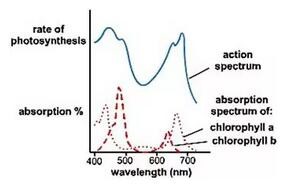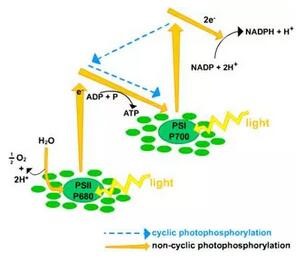摘要:光合作用是A-level生物考试中的一项最基础知识,同学们在学习A-level生物时一定要打好基础,今天教育A Leve网为大家带来A Level生物:光合作用要点概述,希望能为学习A Leve同学提供帮助。
光合作用是A-level生物考试中的一项最基础知识,同学们在学习A-level生物时一定要打好基础,今天教育A Leve网为大家带来A Level生物:光合作用要点概述,希望能为学习A Leve同学提供帮助。

Photosynthesis revision光合作用要点概述
Part 1 Pigments and the Absorption of Light色素与光吸收
At GCSE, you will have used the the following equation:

This shows that carbon dioxide and water are turned into glucose and oxygen in a plant, using light as energy. The glucose made may be used to make other substances or it may be used in respiration. The oxygen may diffuse out through the stomata or it may be used in respiration.
CO2吸收位置: The carbon dioxide enters the plant by stomata (in the leaves) or lenticels (in the stem). The water enters through the roots and moves up through the plant in xylem vessels.
Light is required as an energy source for the reaction and chlorophyll is necessary to absorb the light.
Light energy is necessary but it must be harvested and trapped by the photosynthetic pigments to be of any use.
点击免费领取a-level历年真题+全套内部精选资料+视频课程
叶绿素分类
Chlorophyll absorbs light from the visible part of the electromagnetic part of the spectrum, but there are several types of chlorophyll:
• chlorophyll a
• chlorophyll b
• chlorophyll c
• bacteriochlorophyll (found in photosynthetic bacteria!)
There are also other families of pigments, such as the carotenoids.
不同色素的吸光强度都不一样. 不同部位的色素吸光强度也不一样. Not all wavelengths of light are equally absorbed and different chlorophylls absorb more strongly in different parts of the visible spectrum.
Absorption and Action Spectrums

The action spectrum shows the rate of photosynthesis at different wavelengths.
The absorption spectrum shows how strongly the pigments absorb at different wavelengths.
The absorption spectrum and action spectrum show that the wavelengths that are most strongly absorbed (red and blue) are the ones that cause photosynthesis to proceed at the fastest rate. Green is not strongly absorbed; rather it is reflected, causing leaves to look green.
The shorter the wavelength, the more energy it contains. During photosynthesis the light energy is converted into chemical energy. The absorbed light excites electrons in the pigment molecules and the energy can be passed on to be used by the plant.
Photosystems
The pigments are arranged in funnel shaped photosystems that sit on the thylakoid membranes in the chloroplasts.
In each photosystem, several hundred pigment molecules, called accessory pigments, are clustered around a particular pigment molecule, known as the primary pigment.
The various accessory pigments absorb light of different wavelengths and pass the energy down the photosystem. Eventually the energy reaches the primary pigment that acts as a reaction centre.
There are 2 types of photosystem:
• Photosystem One - PS I:
• Its primary pigment is a molecule of chlorophyll a with an absorption peak at 700nm. It is called P700
• Photosystem Two - PS II:
• Its primary pigment is a molecule of chlorophyll b with an absorption peak at 680nm. It is called P680
PS I are situated next to PS II on the thylakoid membrane.

Part 2 Light Dependant Reactions光反应
The first reactions of photosynthesis require light energy, and are called light dependant reactions.
The aim is to produce ATP from ADP and inorganic P and harvest hydrogen so that carbon dioxide can be reduced to form a carbohydrate in the second series of reactions. The production of ATP using light is called photophosphorylation.
It will be useful if you refer to the Respiration Learn-it, and refresh your memory about electron carriers and the Chemiosmotic theory, as both reappear here.
There are many electron carriers involved, but the one that you must know about for the exams is NADP (nicotinamide adenine dinucleotide phosphate).

When light is absorbed by PS I and PS II, electrons in the chlorophyll molecule are boosted to higher energy levels. They are emitted and passed on to electron carriers.
The loss of electrons from PS II causes the splitting of water. The water gives up its electrons to PS II to fill the gap.
This leaves oxygen, which is given off as waste, and hydrogen ions. (See later in this Learn-it for loss of electrons from PS I).
The electrons are passed through a series of electron carriers at successively lower energy levels. This means that energy is released and used to form ATP out of ADP and P.
This occurs in a similar way to ATP production in mitochondria. The energy is actually used to pump hydrogen ions from the stroma across the thylakoid membrane. This creates an electrochemical gradient.
As the hydrogen ions diffuse back down the concentration gradient they flow through proteins. Part of each protein is ATP synthetase.
The energy released as the hydrogen ions diffuse down the concentration gradient is used to synthesize ATP. The electron eventually reaches PS I and fills the space.
Non-Cyclic Photophosphorylation
The electrons from PS I may also pass onto an electron carrier and then combine with the hydrogen ions (from the water) to reduce NADP to NADPH.
This reduced NADP is used in the next series of reactions.
Note: No ATP has been made during this process.
This process is called non-cyclic photophosphorylation.
Cyclic Photophosphorylation
However, if there is plenty of NADPH, something different happens.
The electron from PS I is passed to the electron carriers used in PS II. ATP is formed and the electrons return to PS I to fill the space. This makes PS II redundant as no electrons are needed from there to fill the space in PS I. Only PS I is active. This is called cyclic photophosphorylation.
To summarise, in cyclic photophosphorylation:
• No PS II is involved.
• No oxygen is evolved.
• No NADPH is made.
• ATP is still made.
点击免费领取a-level历年真题+全套内部精选资料+视频课程
Part 3 Light-Independent reactions暗反应
Calvin cycle
These reactions can occur in the light or the dark. They need ATP for energy to drive the reactions, and they need NADPH for reducing power. They occur in the stroma of the chloroplast and are called the Calvin cycle.
Carbon dioxide combines with a 5-carbon sugar called ribulose bisphosphate (RuBP) to form a 6-carbon sugar. This process is known as carbon fixation and is catalysed by the enzyme ribulose bisphosphate carboxylase (rubisco).
This 6-carbon sugar is unstable and breaks down to form two 3-carbon sugars. These are converted into triose phosphates using the energy from ATP and using the hydrogen from reduced NADP.
Most of this triose phosphate is used to regenerate RuBP, but some is used to produce 6-carbon sugars from which complex carbohydrates, amino acids and other substances are made.
For every twelve 3-carbon sugars (36 carbons):
Two of the 3-carbon sugars form 1 x 6-carbon sugar (6 carbons)
Ten of the 3-carbon sugars form 6 x 5-carbon sugars (RuBP) (30 carbons)
以上就是教育A-level网为大家带来A Level生物:光合作用要点概述的相关介绍,关注(教育A-ALEVE网)更多A-ALEVE考试资讯以及备考资料免费领!
联系电话:400-920-8185
邮箱:tech@sanlischool.com
微信:13734433272
A-level课程优势:
· 课程体系:全程服务,20-32小时集训拔高,80小时自主学习与督导指点我们陪你每一分钟
· 课程资料:1)CIE、Edexcel官方教材;2)独家考前押题秘籍;3)2015-2017年考试真题模考精讲;
· 无忧备考:名师授课+作业批改与点评+ 期中、期末模考精讲+24小时答疑+一直到考前也会进行的伴读计划
· 明星师资:授课老师均毕业于美国TOP30名校和国内985名校,IELTS考分8+,同时教授过至少3000个小时的课程
· 教学方法:超过同类机构两倍的刷题量、考前预测各个击破讲练并进,问答结合,真正掌握每一个知识点

